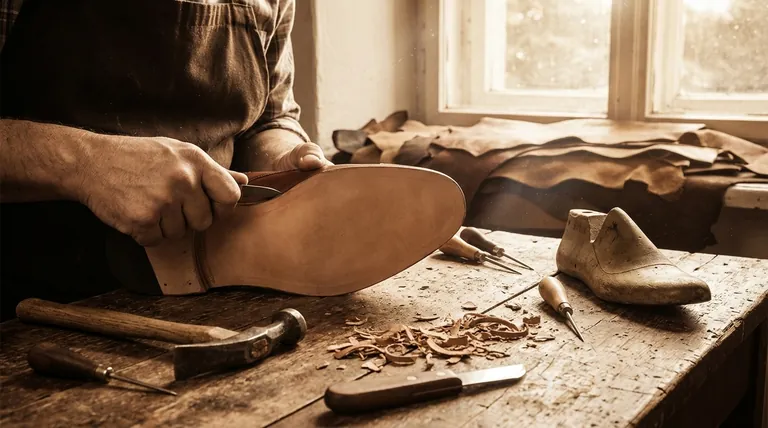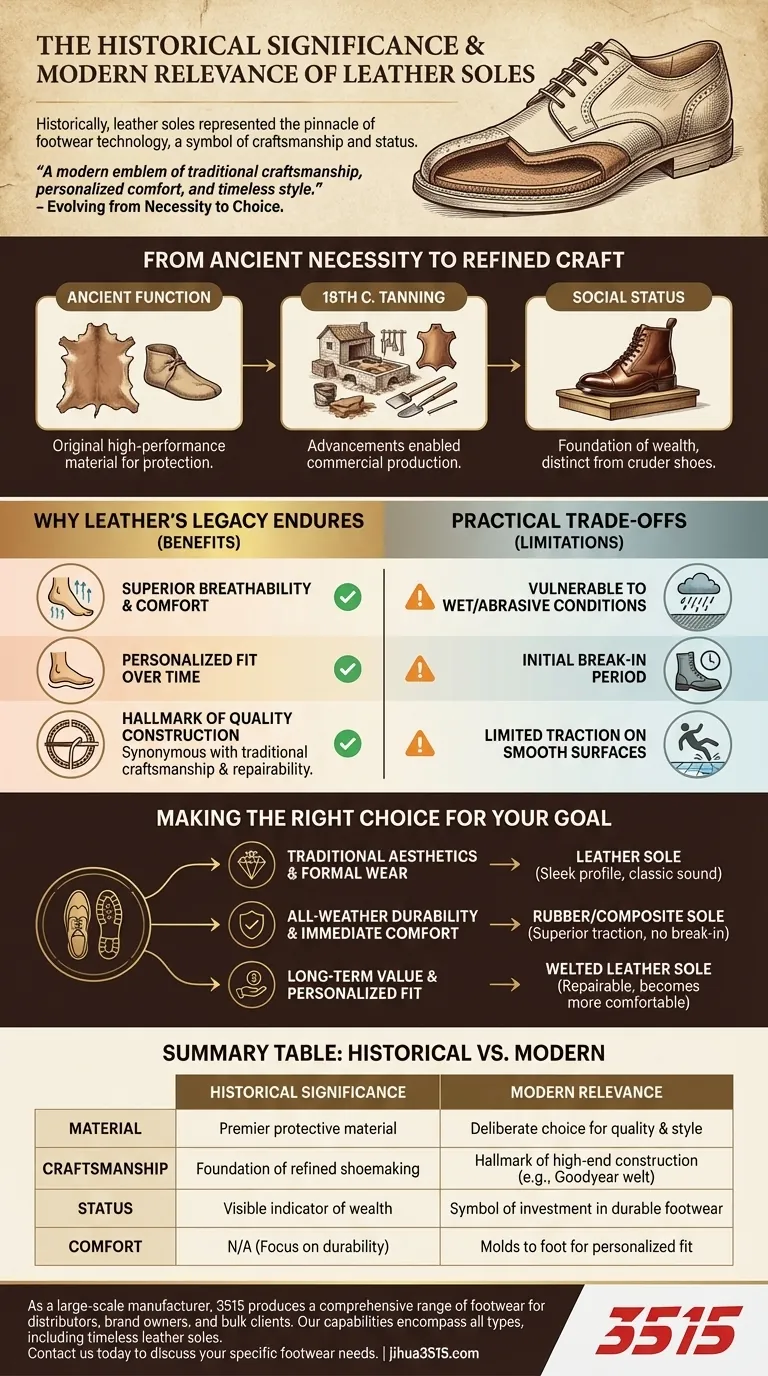Historically, leather soles are significant because for millennia, they represented the pinnacle of footwear technology, offering unmatched durability and protection. This long-standing dominance established them not only as a practical necessity but also as a powerful and visible symbol of craftsmanship, quality, and social status.
The true significance of the leather sole is not just its age, but its evolution from the only viable option into a deliberate choice—a modern emblem of traditional craftsmanship, personalized comfort, and timeless style.

From Ancient Necessity to Refined Craft
The story of the leather sole is the story of footwear itself. For thousands of years, it was the default high-performance material for protecting the human foot.
The Original Functional Material
Long before synthetic alternatives existed, treated animal hide was the premier solution for durable footwear. Its natural toughness protected against rough terrain, making it an essential technology for societies worldwide.
The Impact of Tanning Technology
While tanning is an ancient process, significant advancements by the 18th century allowed for the consistent commercial production of high-quality leather. This turned shoemaking into a more refined and accessible trade, solidifying leather's role as the standard for all quality footwear.
A Foundation for Social Status
Historically, well-made shoes were a clear indicator of wealth and standing. As the foundation of the shoe, a sturdy, well-finished leather sole was an immediate, if subtle, sign that the wearer was a person of means, distinct from the peasantry who might wear cruder shoes or go barefoot.
Why Leather's Legacy Endures
The persistence of leather soles in an age of advanced synthetics is not due to nostalgia alone. It is rooted in unique functional benefits that modern materials often fail to replicate.
Superior Breathability and Comfort
Leather is a naturally porous material. This allows it to breathe and help manage moisture, keeping the foot cooler and drier than a non-porous rubber or plastic sole, which is a critical factor for long-term comfort.
A Personalized Fit Over Time
Perhaps the most prized attribute of a leather sole is its ability to mold to the owner's foot. With wear, the sole flexes and shapes itself to the unique contours of your foot, creating a customized fit and level of support that is difficult to achieve with mass-produced materials.
A Hallmark of Quality Construction
Today, a leather sole is often synonymous with high-quality shoemaking methods, such as a Goodyear welt. This signals that the shoe was built with traditional craftsmanship, durability, and repairability in mind, positioning it as a long-term investment rather than a disposable item.
Understanding the Practical Trade-offs
Despite its benefits, the leather sole is not without its limitations. Objectively choosing the right footwear requires understanding where it excels and where it falls short.
Vulnerability to Abrasive and Wet Conditions
Leather is not impervious to the elements. Excessive exposure to water can cause it to degrade, and walking on highly abrasive surfaces like rough concrete can wear down the sole more quickly than a hard-wearing rubber composite.
The Initial Break-In Period
The same properties that allow leather to mold to your foot mean it often starts out stiff. A new pair of leather-soled shoes typically requires a break-in period before they achieve their renowned level of comfort.
Limited Traction on Smooth Surfaces
Compared to modern rubber compounds, leather offers significantly less grip, especially on smooth, wet surfaces like tile or polished stone.
Making the Right Choice for Your Goal
Selecting a sole material should be a decision driven by your primary needs and the environments you frequent.
- If your primary focus is traditional aesthetics and formal wear: A leather sole is the unparalleled choice, offering a sleek profile and the classic sound that defines dress footwear.
- If your primary focus is all-weather durability and immediate comfort: A high-quality rubber or composite sole will provide superior traction and require no break-in period.
- If your primary focus is long-term value and a personalized fit: A welted leather sole is an excellent investment, as it is fully repairable and will become more comfortable the longer you own it.
Ultimately, appreciating the history of the leather sole is to understand it as a deliberate choice for craftsmanship, comfort, and enduring style.
Summary Table:
| Aspect | Historical Significance | Modern Relevance |
|---|---|---|
| Material | Premier protective material for millennia | A deliberate choice for quality and style |
| Craftsmanship | Foundation of refined shoemaking | Hallmark of high-end construction (e.g., Goodyear welt) |
| Status | Visible indicator of wealth and social standing | Symbol of investment in durable, repairable footwear |
| Comfort | N/A (Historical focus on durability) | Molds to the foot for a personalized fit over time |
As a large-scale manufacturer, 3515 produces a comprehensive range of footwear for distributors, brand owners, and bulk clients. Our production capabilities encompass all types of shoes and boots, including those with the timeless quality of leather soles. Whether you value traditional craftsmanship, modern performance, or a blend of both, we can deliver. Contact us today to discuss your specific footwear needs and discover how we can bring value to your business.
Visual Guide

Related Products
- Custom OEM Training Shoes Wholesale Manufacturer Durable & Breathable
- Safety Footwear Wholesale Manufacturer for Custom OEM/ODM Production
- Durable Leather Safety Boots for Wholesale & Custom OEM Manufacturing
- Wholesale Women's Leather Derby Shoes Custom Factory Production
- Durable Moc-Toe Wedge Work Boots | Wholesale Manufacturing for Brands
People Also Ask
- Which type of footwear is better suited for prolonged use in tough environments? Choose Durable Boots for Maximum Safety & Comfort
- What are the features of non-slip athletic sneakers? The Ultimate Guide to Traction & Performance
- What industries benefit from safety trainers? Lightweight Protection for Modern Workplaces
- What are the main types of reinforced toe protection for tactical boots? Choose the Right Toe for Your Mission
- What are some pros mentioned for women's non-slip shoes? Boost Safety, Comfort & Style



















